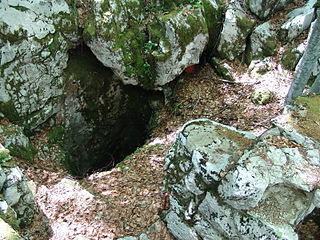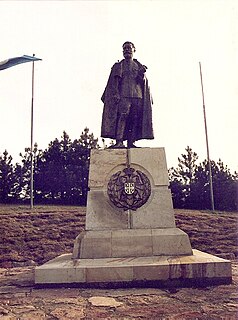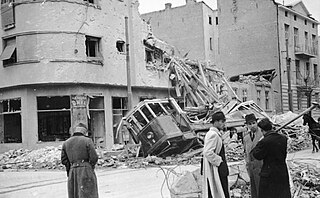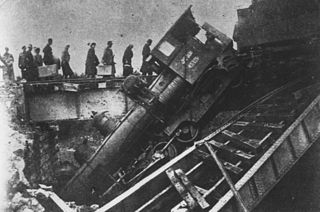 W
WThe Balkans campaign of World War II began with the Italian invasion of Greece on 28 October 1940. In the early months of 1941, Italy's offensive had stalled and a Greek counter-offensive pushed into Albania. Germany sought to aid Italy by deploying troops to Romania and Bulgaria and attacking Greece from the east. Meanwhile, the British landed troops and aircraft to shore up Greek defences. A coup d'état in Yugoslavia on 27 March caused Adolf Hitler to order the conquest of that country.
 W
WBela Crkva incident was an event that took place in village Bela Crkva near Krupanj on 7 July 1941, when a group of Partisans led by Žikica Jovanović Španac killed two gendarmes, who were enforcing ban on political rallies after German occupation of Serbia. The event was latter taken as beginning of uprising in Serbia led by Communist Party of Yugoslavia against Axis occupiers and their collaborators.
 W
WThe Blagaj massacre was the mass killing of around 400 Serb civilians by the Croatian nationalist Ustaše movement on 9 May 1941, during World War II. The massacre occurred shortly after the German-led Axis invasion of Yugoslavia and the establishment of the Ustaše-led Axis puppet state known as the Independent State of Croatia (NDH). It was the second act of mass murder committed by the Ustaše upon coming to power and was part of a wider campaign of genocide against Serbs in the NDH that would last until the end of the war.
 W
WThe Coastal Defence Command was a Royal Yugoslav Army formation which commanded one infantry division and the two fortification divisions responsible for the land defences of the main Yugoslav naval bases during the German-led Axis invasion of the Kingdom of Yugoslavia in April 1941 during World War II. It was responsible for the defence of the Adriatic coast including the two major naval bases at Boka Kotorska and Šibenik. The divisions were the Hercegovina Division, the Boka Kotorska Fortress Division and the Šibenik Fortress Division. The Hercegovina Division was only partly mobilised at the time of the invasion, and the two fortress divisions were still in the process of mobilising. The Coastal Defence Command was supported by a coastal reconnaissance flight based out of Mostar Jasenica Airport, near Mostar.
 W
WThe Yugoslav coup d'état of 27 March 1941 in Belgrade, Kingdom of Yugoslavia, replaced the regency led by Prince Paul and installed King Peter II. It was planned and conducted by a group of pro-Western Serbian-nationalist Royal Yugoslav Army Air Force officers formally led by its commander, General Dušan Simović, who had been associated with several putsch plots from 1938 onwards. Brigadier General of Military Aviation Borivoje Mirković, Major Živan Knežević of the Yugoslav Royal Guards, and his brother Radoje Knežević were the main organisers in the overthrow of the government. In addition to Radoje Knežević, some other civilian leaders were probably aware of the takeover before it was launched and moved to support it once it occurred, but they were not among the organisers.
 W
WGaravice was an extermination location established by the Independent State of Croatia during World War II near Bihać, northwest Bosnia and Herzegovina. Between 12,000 and 15,000 people, mostly Serb civilians, were murdered at Garavice by the Ustaše regime in 1941.
 W
WHomogeneous Serbia is a written discourse by Stevan Moljević. In this work, contrary to the presumptions of Ilija Garašanin who believed that the strength of the state is derived from its size and organizational principles, Moljević emphasized that the state drew its strength from the degree to which its population identifies itself within the state. Moljević believed that the victorious Kingdom of Serbia in 1918 made a grave mistake when it decided to establish Yugoslavia instead of clearly defining the borders of Serbia.
 W
WThe Invasion of Yugoslavia, also known as the April War or Operation 25, was a German-led attack on the Kingdom of Yugoslavia by the Axis powers which began on 6 April 1941 during World War II. The order for the invasion was put forward in "Führer Directive No. 25", which Adolf Hitler issued on 27 March 1941, following a Yugoslav coup d'état that overthrew the pro-Axis government.
 W
WThe Jadovno concentration camp was a concentration and extermination camp in the Independent State of Croatia (NDH) during World War II. Commanded by Juco Rukavina, it was the first of twenty-six concentration camps in the NDH during the war. Established in a secluded area about 20 kilometres (12 mi) from the town of Gospić, it held thousands of Serbs and Jews over a period of 122 days from May to August 1941. Inmates were usually killed by being pushed into deep ravines located near the camp. Estimates of the number of deaths at Jadovno range from 10,000 to 68,000, mostly Serbs. The camp was closed on 21 August 1941, and the area where it was located was later handed over to the Kingdom of Italy and became part of Italian Zones II and III. Jadovno was replaced by the greater sized Jasenovac concentration camp and its extermination facilities.
 W
WThe Battle of Loznica involved an attack on the German garrison of that town by the Jadar Chetnik Detachment on 31 August 1941. Following the World War II German-led Axis invasion of Yugoslavia in April 1941, the Kingdom of Yugoslavia was partitioned. At the time, Loznica was part of the German-occupied territory of Serbia, which included Serbia proper, with the addition of the northern part of Kosovo, and the Banat.
 W
WOperation Mihailovic was the final World War II German anti-guerrilla offensive to suppress the Serbian Chetnik detachments of the Yugoslav Army, headed by Colonel Dragoljub Mihailović. The offensive took place from 4 to 9 December 1941 near Šumadija, in the Territory of the Military Commander in Serbia.
 W
WThe Museum of 4 July was a museum located in Belgrade, the capital of Serbia. It was established in 1950 in the house where members of the Central Committee of the Communist Party of Yugoslavia decided to encourage the people's uprising against Yugoslavia's German occupiers on 4 July 1941. That date was later dubbed Fighter's Day, a public holiday during the existence of Socialist Federal Republic of Yugoslavia.
 W
WOperation Retribution, also known as Operation Punishment, was the April 1941 German bombing of Belgrade, the capital of Yugoslavia, in retaliation for the coup d'état that overthrew the government that had signed the Tripartite Pact. The bombing occurred in the first days of the German-led Axis invasion of Yugoslavia during World War II. The Royal Yugoslav Army Air Force (VVKJ) had only 77 modern fighter aircraft available to defend Belgrade against the hundreds of German fighters and bombers that struck in the first wave early on 6 April. Three days prior, VVKJ Major Vladimir Kren had defected to the Germans, disclosing the locations of multiple military assets and divulging the VVKJ's codes.
 W
WThe Uprising in Montenegro (Serbo-Croatian: Ustanak u Crnoj Gori / Устанак у Црној Гори), commonly known as the 13 July Uprising (Serbo-Croatian: Trinaestojulski ustanak / Тринаестојулски устанак) was an uprising against Italian occupation forces in Montenegro. Initiated by the Communist Party of Yugoslavia on 13 July 1941, it was suppressed within six weeks, but continued at a much lower intensity until December 1941. The insurgents were led by a combination of communists and former Royal Yugoslav Army officers from Montenegro. Some of the officers had recently been released from prisoner-of-war camps following their capture during the invasion of Yugoslavia. The communists managed the organisation and provided political commissars, while the insurgent military forces were led by former officers. The entire nation rejected the privileged position offered by its occupiers, rejected the capitulation in order to fight for Yugoslavia, together with "Russia".
 W
WThe Uprising in Serbia was initiated in July 1941 by the Communist Party of Yugoslavia against the German occupation forces and their Serbian auxiliaries in the Territory of the Military Commander in Serbia. At first the Yugoslav Partisans had mounted diversions and conducted sabotage and had attacked representatives of Aćimović's collaborationist administration. In late August some Chetniks joined the uprising and liberated Loznica. The uprising soon reached mass proportions. Partisans and Chetniks captured towns that weak German garrisons had abandoned. The armed uprising soon engulfed great parts of the occupied territory. The largest liberated territory in occupied Europe was created by the Partisans in western Serbia, and was known as the Republic of Užice. Rebels shared power on the liberated territory; the center of the Partisan liberated territory was in Užice, and Chetniks had their headquarters on Ravna Gora.
 W
WOperation Uzice was the first major counter-insurgency operation by the German Wehrmacht on the occupied territory of the Kingdom of Yugoslavia during World War II. The operation was directed against the Užice Republic, the first of several "free territories" liberated by the Yugoslav Partisans. It was named after the town of Užice, and is associated with the First Enemy Offensive in Yugoslavian historiography. The security forces of the German-installed puppet regime of Milan Nedić also participated in the offensive.